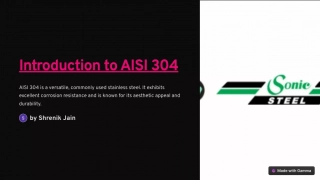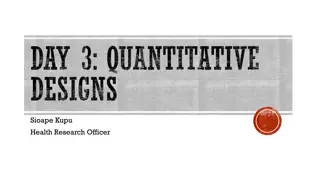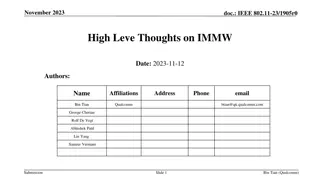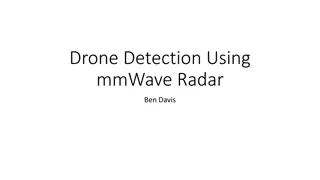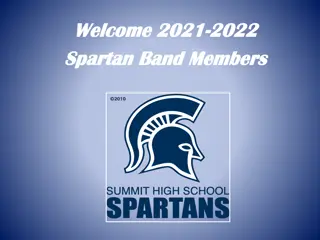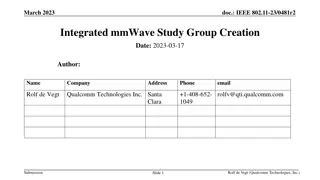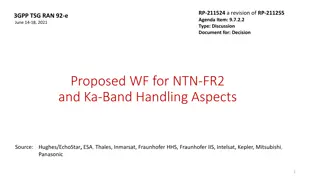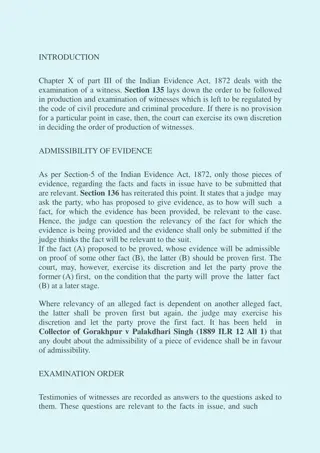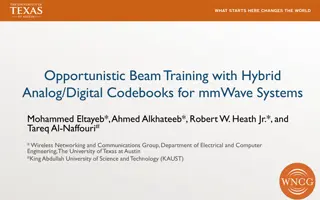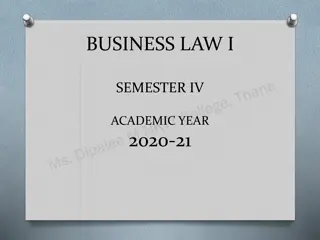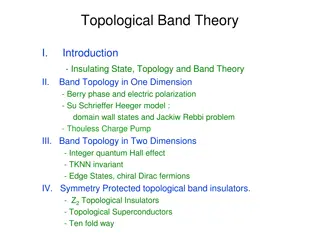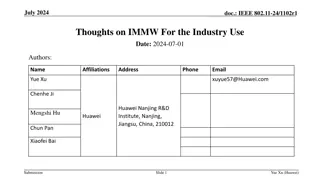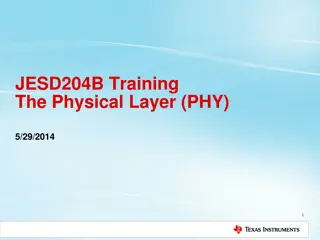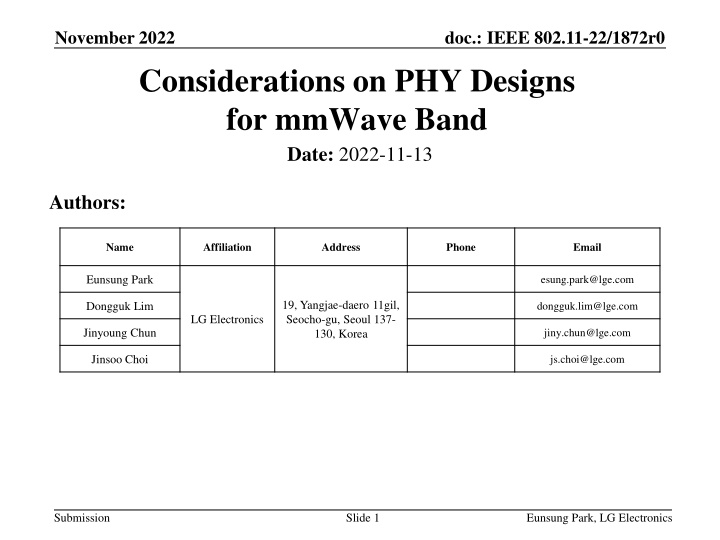
Design Considerations for mmWave Band PHY in IEEE 802.11-22/1872r0
Explore the considerations for PHY designs in the mmWave band, focusing on numerology aspects like bandwidth, guard interval, and subcarrier spacing. Detailed analysis of 1x and 4x numerologies, their differences, and implications for implementation are discussed, along with insights into upclocked bandwidths and FFT sizes for improved throughput in advanced wireless technologies.
Download Presentation

Please find below an Image/Link to download the presentation.
The content on the website is provided AS IS for your information and personal use only. It may not be sold, licensed, or shared on other websites without obtaining consent from the author. If you encounter any issues during the download, it is possible that the publisher has removed the file from their server.
You are allowed to download the files provided on this website for personal or commercial use, subject to the condition that they are used lawfully. All files are the property of their respective owners.
The content on the website is provided AS IS for your information and personal use only. It may not be sold, licensed, or shared on other websites without obtaining consent from the author.
E N D
Presentation Transcript
November 2022 doc.: IEEE 802.11-22/1872r0 Considerations on PHY Designs for mmWave Band Date: 2022-11-13 Authors: Name Affiliation Address Phone Email Eunsung Park esung.park@lge.com 19, Yangjae-daero 11gil, Seocho-gu, Seoul 137- 130, Korea Dongguk Lim dongguk.lim@lge.com LG Electronics Jinyoung Chun jiny.chun@lge.com Jinsoo Choi js.choi@lge.com Submission Slide 1 Eunsung Park, LG Electronics
November 2022 doc.: IEEE 802.11-22/1872r0 Introduction Several contributions considered mmWave band operation as one of the potential features for UHR [1-6] Various benefits and target objectives were presented Reusing existing PHY designs was dealt with as a way to enable mmWave band operation in some of the contributions There are still some issues to be discussed even when reusing existing PHY designs In [6], several aspects such as hardware challenges, CFO and phase noise were discussed In this contribution, we present our considerations on several PHY designs such as numerology, SU / MU MIMO, PPDU format and MCS for mmWave band operation As to the numerology, we consider three aspects as follows Bandwidth, guard interval and subcarrier spacing Submission Slide 2 Eunsung Park, LG Electronics
November 2022 doc.: IEEE 802.11-22/1872r0 Numerology We have 1x and 4x numerologies which are based on 11ac and 11be, respectively One of them can be reused to determine tone plans and symbol structures in a mmWave band for a simple implementation M: mandatory O: optional There are several differences between 1x and 4x numerologies 1x numerology (11ac) 4x numerology (11be) Bandwidth (FFT size) M: 20 MHz, 40 MHz, 80 MHz (64, 128, 256) O: 160 MHz (512) M: 20 MHz, 40MHz, 80 MHz (256, 512, 1024) O: 160 MHz, 320 MHz (2048, 4096) Note: 160 MHz is mandatory for AP Guard Interval M: 0.8 us O: 0.4 us M: 0.8 us, 1.6 us, 3.2 us Subcarrier spacing 312.5 KHz 78.125 KHz We deal with these three aspects to discuss which numerology is proper Submission Slide 3 Eunsung Park, LG Electronics
November 2022 doc.: IEEE 802.11-22/1872r0 Numerology: Bandwidth (1/2) Background Upclocked bandwidths can be used to offer better throughput In [4], 160 to 1280 MHz bandwidths were considered and it seems that 8 times upclocking is applied to the conventional bandwidths In 5G NR, up to 400 MHz with 60 / 120 / 240 KHz subcarrier spacing is supported for FR2 (mmWave band) while up to 100 MHz with 15 / 30 / 60 KHz subcarrier spacing is supported for FR1 (sub-6 GHz) In 11ay, bandwidths from 2.16 to 8.64 GHz with FFT sizes from 512 to 2048 are defined Pros and Cons 1x numerology may have less hardware complexity because of the smaller FFT size 4x numerology can support much wider bandwidth assuming the same upclocking because it supports up to 320 MHz Submission Slide 4 Eunsung Park, LG Electronics
November 2022 doc.: IEEE 802.11-22/1872r0 Numerology: Bandwidth (2/2) Feasibility Upclocking may further increase the complexity since much faster hardware processing is needed due to a high sampling rate Considering the bandwidths and FFT size defined in 11ay, reusing both 1x and 4x numerologies with 8 times upclocking may be feasible from the hardware perspective 1x numerology with 8 times upclocking leads to bandwidths from 160 to 1280 MHz with FFT sizes from 64 to 512 4x numerology with 8 times upclocking leads to bandwidths from 160 to 2560 MHz with FFT sizes from 256 to 4096 It seems that more than 8 times upclocking is possible Further required work Implementation aspects and challenges need to be investigated to determine proper upclocked bandwidths Submission Slide 5 Eunsung Park, LG Electronics
November 2022 doc.: IEEE 802.11-22/1872r0 Numerology: Guard Interval (1/2) Background GI mitigates inter-symbol interference (ISI) caused by delay spread at the expense of overhead In 11ay, 36.36 ns guard interval (GI) is defined Assuming 8 times upclocking, 1x and 4x numerologies have 0.1 / 0.05 us GI and 0.1 / 0.2 / 0.4 us GI, respectively Pros and Cons 1x numerology has an overhead reduction option of 0.05 us GI Note that this does not mean 1x numerology is better in terms of the overhead, and, basically, 4x numerology has less overhead because of a longer symbol period 0.05 us GI is the most similar value to the GI defined in 11ay 4x numerology is more robust against ISI since it has various wide GI options Submission Slide 6 Eunsung Park, LG Electronics
November 2022 doc.: IEEE 802.11-22/1872r0 Numerology: Guard Interval (2/2) Feasibility Many research papers [7-10] showed that in 60 GHz, most of the delay spreads are measured within 0.1 us even in NLoS environments no matter if it is indoor or outdoor 0.1 us GI may be enough, i.e., 1x numerology with 8 times upclocking may be feasible In LoS, delay spreads are measured around 10 ns, and thus, 0.05 us may be applicable Further required work Delay spread impact should be investigated under various GIs Based on the investigation, possible GIs can be determined and wider or shorter GI can be further introduced to effectively mitigate ISI or to further reduce overhead Additional GIs cause a slight modification of existing PHY designs, and thus, impacts on implementation also need to be checked Submission Slide 7 Eunsung Park, LG Electronics
November 2022 doc.: IEEE 802.11-22/1872r0 Numerology: Subcarrier Spacing (1/2) Background There are several impairment factors which cause inter-carrier interference (ICI) The wider subcarrier spacing, the more robust against ICI In 11ay, 5.156 MHz subcarrier spacing is defined In a mmWave band, phase noise has a more harmful effect than that in a sub-7 GHz band due to frequency multipliers of local oscillators and phase noise floor in a wide bandwidth [11] Pros and Cons 1x numerology which has a wider subcarrier spacing may be better in terms of ICI 4x numerology which has a narrower subcarrier spacing resulting in a longer symbol period has less GI overhead and better throughput Submission Slide 8 Eunsung Park, LG Electronics
November 2022 doc.: IEEE 802.11-22/1872r0 Numerology: Subcarrier Spacing (2/2) Feasibility Considering the subcarrier spacing defined in 11ay, around 5 MHz subcarrier spacing may be feasible 16 and 64 times upclocked bandwidths are needed for 1x and 4x numerologies, respectively, which yield 5 MHz subcarrier spacing 4x numerology may need too much increase in hardware complexity Further required work Overall impacts of impairment factors causing ICI should be identified under various subcarrier spacing values Based on the investigation, possible subcarrier spacing values can be determined which are directly related to upclocking Submission Slide 9 Eunsung Park, LG Electronics
November 2022 doc.: IEEE 802.11-22/1872r0 Numerology: Summary Summary for numerology 1x numerology (11ac) 4x numerology (11be) Required work Bandwidth (FFT size) Relatively less complex Higher throughput Hardware complexity Guard Interval Maybe feasible in terms of ISI (assuming 8 times upclocking) More robust against ISI Delay spread impact Subcarrier spacing More robust against ICI Less GI overhead and better throughput Phase noise impact Overall, 1x numerology has relatively low complexity whereas 4x numerology has better throughput Many factors such as complexity, impairments, performance, and so on are involved in determining reasonable numerology Further investigation is required for detailed designs Submission Slide 10 Eunsung Park, LG Electronics
November 2022 doc.: IEEE 802.11-22/1872r0 SU / MU MIMO Background In 11ay, SU MIMO and DL MU MIMO are optionally supported up to 8 spatial streams (SS) by using array antennas with polarization based on a beamforming training procedure and only SU transmission with 1 SS is mandatory Feasibility Basically, SU transmission with 1 SS can be supported based on a simple sector sweep method Although we can also consider SU MIMO and DL MU MIMO by reusing the beamforming training procedure defined in 11ay or introducing a new design, to minimize the implementation burden and complexity, it would be better to adopt these schemes later Further required work A simple sector sweep method needs to be designed for SU transmission with 1 SS We can further check on whether the MIMO and MU transmission schemes are needed in UHR considering the complexity, objectives and use cases Additionally, feasibility of UL MU MIMO and DL/UL MU OFDMA can be also investigated for future expansion if needed Slide 11 Submission Eunsung Park, LG Electronics
November 2022 doc.: IEEE 802.11-22/1872r0 PPDU Format (1/2) Background When it comes to the design of PPDU format, coexistence and backward compatibility is one of the important factors UHR PPDU for sub-7 GHz also needs to begin with the legacy preamble Whereas these factors may be less important in a mmWave band because of a low interference nature with directional antennas and large signal attenuation Feasibility Although there are 11ad / 11ay STAs currently in 60 GHz, we might not have to care about them too much thanks to the mmWave band properties mentioned above Hence, UHR PPDU in a mmWave band can start with UHR STF followed by UHR LTF, UHR SIG and Data field Each field can reuse existing field designs especially for STF and LTF This format can diminish the overhead but additional implementation is required for a different PPDU format from the sub-7 GHz one In addition, training fields can be added at the end of the PPDU for beam refinement similar to 11ay Submission Slide 12 Eunsung Park, LG Electronics
November 2022 doc.: IEEE 802.11-22/1872r0 PPDU Format (2/2) Further required work Reasonable PPDU formats should be discussed To minimize the implementation burden and complexity, we can focus only on SU transmission and we can additionally consider the MU transmission later if needed An additional PPDU which is used only for the sector sweep and beam refinement can be considered for overhead reduction It may be different from SU PPDU Efficient training field designs may be necessary and it can reuse existing STF / LTF designs as a simple approach Submission Slide 13 Eunsung Park, LG Electronics
November 2022 doc.: IEEE 802.11-22/1872r0 MCS Background Since mmWave band operation is vulnerable to the phase noise which degrades EVM, it may be difficult to apply high MCSs without an additional increase in hardware cost / complexity Although 11ay supports up to 64 QAM, only BPSK and QPSK are mandatory for the EDMG SC mode Feasibility Similar to 11ay, only some low MCSs can be chosen as (conditional*) mandatory MCSs even though MCSs up to 64 QAM and 256 QAM are mandatory in 11ac and 11be, respectively Although this may degrade the throughput, we have several alternatives to compensate it, e.g., wider bandwidths and multi-link operation Further required work Phase noise and EVM impact should be investigated according to various MCSs Based on the investigation, possible MCSs can be determined We can further check on whether high MCSs are needed in UHR considering the complexity, objectives and use cases * If we decide to adopt mmWave band operation, we also need to determine whether it is mandatory or optional Submission Slide 14 Eunsung Park, LG Electronics
November 2022 doc.: IEEE 802.11-22/1872r0 Conclusion We have provided our considerations on several PHY designs such as numerology, SU / MU MIMO, PPDU format and MCS for mmWave band operation We can reuse existing PHY designs in sub-7 GHz as much as possible for simplicity, but there are still several issues To determine details of each design, many factors such as impairments, performance, complexity, etc., need to be further discussed To minimize the implementation burden and complexity, it would be better to focus on simple features Some other complex features can be considered in the next UHR Submission Slide 15 Eunsung Park, LG Electronics
November 2022 doc.: IEEE 802.11-22/1872r0 References [1] 11-22-0046-01-0wng-next-generation-after-802-11be [2] 11-22-0729-01-0wng-next-generation-after-802-11be-follow-up [3] 11-22-1083-01-0wng-next-generation-sg-formation [4] 11-22-1595-01-0uhr-some-questions-to-answer-in-the-sg [5] 11-22-1580-01-0uhr-aperspectiveonproposeduhrfeaturesforenterpriseusecases [6] 11-22-1395-00-0uhr-thoughts-on-high-frequency-band [7] H. Xu, V. Kukshya, and T. S. Rappaport, Spatial and Temporal Characteristics of 60-GHz Indoor Channels , IEEE J. Sel. Areas Commun., vol. 20, no. 3, pp. 620 630, Apr. 2002. of 60-GHz indoor channels, [8] S. Salous, S. M. Feeney, X. Raimundo, and A. A. Cheema, Wideband MIMO Channel Sounder for Radio Measurements in the 60 GHz Band , IEEE Tran. Wireless Commun., vol. 15, no. 4, pp. 2825-2832, Apr. 2016 [9] X. Wu, C.-X. Wang, J. Sun, J. Huang, R. Feng, Y. Yang, and X. Ge, 60-GHz Millimeter-Wave Channel Measurements and Modeling for Indoor Office Environments , IEEE Trans. Antennas Propag., vol. 65, no. 4, pp. 1912- 1924, Apr. 2017 [10] V. Raghavan, A. Partyka, L. Akhoondzadehasl, A. Tassoudji, O. Koymen, and J. Sanelli, Millimeter Wave Channel Measurements and Implications for PHY Layer Design , IEEE Trans. Antennas Propag., vol. 65, no. 12, pp. 6521-6533, Dec. 2017 [11] 11-15-0866-04-00ay-11ay-evaluation-methodology Submission Slide 16 Eunsung Park, LG Electronics

